Nancy Bilyeau's Blog, page 29
January 14, 2014
The Secrets of the Westminster Gatehouse Prison
I had one of my research "Aha!" moments while chasing down facts about Westminster Hall and Whitehall Palace, where my Joanna Stafford spends pivotal chapters in The Covenant.
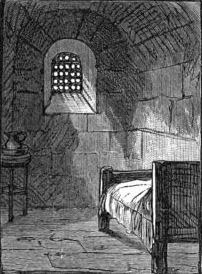 I learned that in the reign of Edward III a gatehouse quite close to Westminster Abbey was converted into a prison. I couldn't stop reading about the people who were kept there, from Sir Walter Ralegh and Samuel Pepys to a Catholic-leaning dwarf to a brazen woman bigamist. The more I dug, the more stories I discovered.
I learned that in the reign of Edward III a gatehouse quite close to Westminster Abbey was converted into a prison. I couldn't stop reading about the people who were kept there, from Sir Walter Ralegh and Samuel Pepys to a Catholic-leaning dwarf to a brazen woman bigamist. The more I dug, the more stories I discovered.
To read about this fascinating prison, go to my blog.
 I learned that in the reign of Edward III a gatehouse quite close to Westminster Abbey was converted into a prison. I couldn't stop reading about the people who were kept there, from Sir Walter Ralegh and Samuel Pepys to a Catholic-leaning dwarf to a brazen woman bigamist. The more I dug, the more stories I discovered.
I learned that in the reign of Edward III a gatehouse quite close to Westminster Abbey was converted into a prison. I couldn't stop reading about the people who were kept there, from Sir Walter Ralegh and Samuel Pepys to a Catholic-leaning dwarf to a brazen woman bigamist. The more I dug, the more stories I discovered.To read about this fascinating prison, go to my blog.
Published on January 14, 2014 10:54
December 4, 2013
Celebration: My Second Novel Appears in Germany
I'm very proud that Germany made a multiple-book deal, and on Dec. 4, 2013, my second novel was published by DTV. The name of the book is not "The Chalice" but "The Prophecy of the Nun." I like that title, just as I liked "The Last Nun" instead of "The Crown." But then again, "The Last Nun" was my original title for my first book. It was changed after I sold it.
The cover of the German book is also quite interesting:
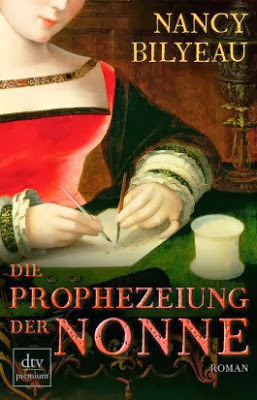
I'm told that the German market for historical novels set in England is strong. So let's hope that "The Prophecy of the Nun" finds its way into a lot of homes!
Published on December 04, 2013 13:45
December 2, 2013
Hans Holbein: Artist as Politician

What if your livelihood--if not your life--depended on pleasing a vain king who was the essence of mercurial? Such was the predicament of Hans Holbein the Younger in the court of Henry VIII.
Read my blog post on English Historical Fiction Authors to learn more!
Go to: http://englishhistoryauthors.blogspot.com/2013/11/hans-holbein-politics-of-art-in-court.html?spref=tw
Published on December 02, 2013 04:17
November 26, 2013
Blogging About the Tudors
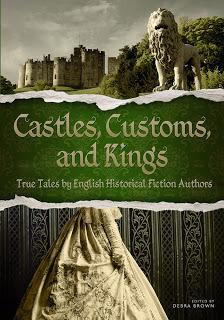
I wrote a guest post about my nonfiction writing for the wonderful people at QueenAnneBoleyn.com. This is part of raising awareness for the new anthology, Castles, Customs and Kings: True Tales by English Historical Fiction Authors. Many of the writers who contribute to the group blog at English Historical Fiction Authors pitched in with chapters for this book, which stretches from the age of Boudicca to that of Downton Abbey. I wrote six chapters on Tudor England myself.
To learn more, go to:
http://queenanneboleyn.com/2013/11/18/blogging-about-the-tudors-by-nancy-bilyeau/
Published on November 26, 2013 12:19
October 9, 2013
"The Paranoid State of Tudor England"
By Nancy Bilyeau
There is an incredible sentence in the respected UK book site Crimereview: "No-one reflects the paranoid state of Tudor England better than Nancy Bilyeau."
What an honor!
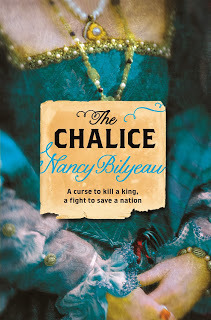 UK Orion Books' cover of The ChaliceThe review, published last week, begins this way:
UK Orion Books' cover of The ChaliceThe review, published last week, begins this way: "Joanna Stafford, niece of the disgraced and beheaded Duke of Buckingham, herself of royal Plantagenet blood and maid of honour to Queen Katherine of Aragon, became my favourite heroine when she made her debut last year in Crown.
"Now the beautiful half-Spanish former novice nun is once again caught in the bitter web of internal and international politics that is the England of Henry VIII, where a careless word can send earl or bishop, lord or commoner to torture, the execution block or the stake. Thomas Cromwell, acting on behalf of a king increasingly desperate to sire a son, completes his ruthless destruction of the monasteries, earning the hate of both the Pope and the Catholic sovereigns of Europe who would use their religion to mask territorial ambitions."
To read the full review, go to http://www.crimereview.co.uk/page.php/review/176
Published on October 09, 2013 08:11
September 29, 2013
Nancy Bilyeau Historical Fiction Giveaway
I'd like to give away one of my books in this fun historical-fiction hop!
I'm writing a suspense trilogy set in the 16th century, published by Touchstone/Simon & Schuster in North America and Orion Books in the United Kingdom. The fictional protagonist is Joanna Stafford, a daughter of an English aristocrat and Spanish lady-in-waiting who is drawn to the spiritual life and becomes a novice at the only order of Dominican nuns in England, just as the religious orders of England face a violent destruction. Each novel tells a suspenseful tale, with the backdrop of the harrowing Dissolution of the Monasteries-- from a point of view rarely seen in fiction.
The Crown takes place in 1537 and 1538, when Henry VIII's break with Rome throws hundreds of monasteries and convents into turmoil. To save her father and her way of life from destruction, Joanna is forced to find a mysterious relic but then must decide who can be trusted with its powers.
The Chalice covers 1538 to early 1540, when Joanna along with thousands of other men and women expelled from their orders are struggling to find a place for themselves. In this book, a traumatized Joanna discovers she is part of a prophecy about the fate of the kingdom, and she must decide between her conscience and a violent act that could bring back her beloved way of life.
The Covenant, which plunges Joanna into the court of Henry VIII during one of his most lethal years, 1540, will come out in 2014. I'm finishing it now. :)
I will share a few reviews of the first two books:
The Crown:
“Bilyeau deftly weaves extensive historical research throughout, but the real draw of this suspenseful novel is its juicy blend of lust, murder, conspiracy, and betrayal.” – O, The Oprah Magazine
“An engrossing thriller…[the] extensive historical research shines.” – Entertainment Weekly
“Bilyeau weaves her breathtaking story though a string of events to a pleasing conclusion while giving the reader a more thorough understanding of a complicated bit of history. Historical fiction as it should be.” – Florida Times-Union
The Chalice:
"English history buffs and mystery fans alike will revel in Nancy Bilyeau's richly detailed sequel to The Crown." -- Parade “Bilyeau continues from her first novel the subtle, complex development of Joanna’s character and combines that with a fast-paced, unexpected plot to hold the reader’s interest on every page . . . history and supernatural mysticism combine in this compelling thriller.” -- Historical Novel Society
“The novel is riveting, and provides fascinating insight into the lives of displaced nuns and priests during the tumultuous Tudor period. Bilyeau creates fully realized characters, with complex actions and emotions, driving the machinations of these historic personages.” -- RT Book Reviews (Top Pick))-----------------------------------------------------------------------------------------------
For this giveaway, I will send a signed paperback of The Crown or a signed hardcover of The Chalice to anyone in North America.
Published on September 29, 2013 11:39
September 22, 2013
Stafford Castle: Blog Hop & Giveaway

By Nancy Bilyeau
It is a pleasure and honor to be included in the new anthology Castles, Customs, and Kings: True Tales by English Historical Fiction Authors. More than 50 novelists contributed, sharing their passion for history, from Boudicca's war on the Roman invaders to Downton Abbey-era chandelier polishing. To see the amazon page, go here..
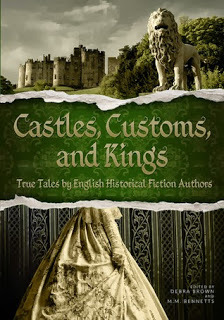
I wrote five essays for the book, sharing my interest in Tudor England and, specifically, the turmoil of the Reformation. My chapters include "The Truth About Torture in the Tower of London" and "The Death of Henry VIII: Demolishing the Myths."
The protagonist of The Crown and The Chalice, Joanna Stafford, is fictional but the family was quite real. The Staffords played an important part in the War of the Roses, fighting on the side of Lancaster. But through a royal marriage and aggressive acquiring of land and titles, the Staffords had became too rich and powerful as far as the reigning monarchs were concerned. Richard III had Henry Stafford, 2nd duke of Buckingham, executed for treason. A generation later, Henry VIII ordered the death of Edward Stafford, 3rd duke of Buckingham, also for treason.
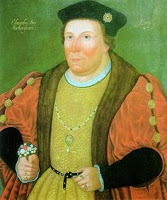 Edward Stafford, 3rd duke of Buckingham
Edward Stafford, 3rd duke of BuckinghamThe family's rise and fall is inextricably linked to Stafford Castle, in the west midlands. For this blog hop, we were asked to write about a castle and I happily leaped at the opportunity to share some haunting images of the remains of this once proud medieval castle, which stands tall against the sky on the edge of a ridge. And I'd like to tell you some choice tales taken from centuries of history of this fascinating family.
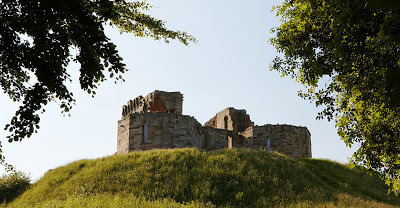
Stafford Castle possesses a long, rich, and relatively well documented history. A wooden building was raised on the hill in the 1070s by a Norman lord worried about the rebellious Saxon population. In 1347, Ralph de Stafford, a supporter of Edward III and founding member of the Order of the Garter, built a stone castle on the same site. Ralph was a tough, ambitious and ruthless soldier, still leading troops when he was 60 years old. After his first wife died, he abducted a wealthy young heiress and married her, ignoring the outrage of her parents. When the girl's family turned to Edward III for justice, he refused to order Stafford to give up his bride. Instead, he gave the parents more titles.
The great-grandson of this roughly made union was Humphrey Stafford, first duke of Buckingham. Stafford Castle's heyday was during the life of Duke Humphrey, who built a massive rectangular stone keep, a tower in each corner.
 The castle's "interior," today
The castle's "interior," todayCarole Rawcliffe, in the book The Staffords, wrote:
"The first Duke of Buckingham's household was an itinerant body which accompanied him from one lordship to another as he toured his estates or executed official business....The oldest and in many ways the most impressive was Stafford Castle, where Duke Humphrey kept a large stable with a resident staff of over forty yeomen and grooms. The castle, dominating the town and its environs, provided an ideal recruitment centre and assembly point for his retainers in Cheshire, Staffordshire and the Welsh March."
Duke Humphrey died in the Battle of Northampton, leading the Lancastrian army at the age of 58. Before the battle in support of King Henry VI he had informed the Yorkist side via messenger: "The Earl of Warwick shall not come to the king's presence and if he comes he shall die." The duke was not able to keep that promise; he was slain by Yorkist soldiers outside Henry VI's tent, defending his king to the last.
 Humphrey Stafford
Humphrey StaffordThe second Duke of Buckingham also exhibited the family's taste for bravado. He helped Richard, Duke of Gloucester, take possession of the teenage Edward V, conveying him to the Tower of London. But then he turned against Richard once he became king, led a rebellion and was beheaded for his betrayal.
As for the third duke, one of the richest men in the kingdom, he was an early victim of Henry VIII's paranoia about relatives who could try to take his throne. There was little proof of treason introduced at Edward Stafford's trial except for testimony that he'd met with a monk who prophesied the future of Henry VIII--how long would he live and whether he'd have a son. To the Tudors, this was more than enough.
The family never recovered from the death of Buckingham in 1521. Although Stafford Castle was the family seat, the duke had lived most of the time in such grand homes as Thornbury Castle. But all of this property was seized by the crown after Buckingham's death and his widow and children were left with nothing at first. After a couple of years, Henry VIII returned one home--Stafford Castle--to the devastated clan. It was all that remained of their vast holdings across the kingdom.
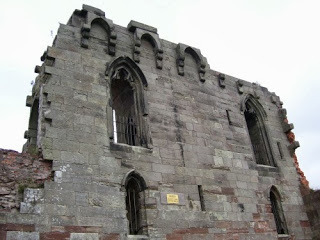
The oldest son, Henry, Lord Stafford, lived at the castle with his wife, Ursula, and their 14 children for the rest of his life. Fearful of drawing attention, he played no part in politics and rarely attended court. He spent pleasurable hours in his private library, which included at least 300 books, translating works from Latin and dabbling in writing himself. He was in some ways the anti-Stafford.
The problem was the head of the family owned almost no land beyond the immediate vicinity of the castle, and his need for money was intense.
That is why on April 27, 1536, Lord Stafford wrote this craven letter to Thomas Cromwell, chief minister of Henry VIII:
"Though I am least able to serve you, yet the comfort you gave me makes me bold to write to you. I beg you will use means with the King that I may have the farm of the abbey of Rantone, if it be dissolved. It is within four miles of my house and reaches my park pale, and I will give as much for it as any man. I heard that the Queen had moved the King to have me in remembrance for it, and he was content, saying it was alms to help me, having so many children on my hands. I heard that Geo. Blunt endeavours to obstruct my suit. By the last act of the Lords Marchers my income will be 20l. a year less. In the matter which I showed you of my lord of Wiltshire's motion, pray make my humble submission to the King."
The queen in question was Anne Boleyn and the "lord of Wiltshire" her father. Apart from the fact that it was unlikely that the Reform-minded queen would support the cause of an old Catholic disenfranchised aristocratic family, there were pressing matters in the kingdom that put Stafford's request at the bottom of any list. Cromwell was interrogating suspected lovers of the queen at the end of April. Anne Boleyn would be arrested and beheaded in May. Poor Henry Stafford had made his desperate plea for patronage of the wrong faction.

Henry Stafford had better luck when Mary Tudor succeeded to the throne. He petitioned the queen for financial assistance in 1554 and was made a chamberlain of the exchequer, a position that brought him 50 pounds a year.
Lord Stafford died in his bed at the age of 62. The castle continued to crumble, and his grandson referred to it as "my rotten castle of Stafford" in 1603.
Which brings us to Lady Isabel Stafford. When the Civil War broke out, the family still held the castle, though how is hard to imagine. They had the dusty prestige of the name "Stafford," but the dukedom of Buckingham had been given away to favorites of the Stuart monarchy long ago.
Nonetheless, Lady Isabel showed the same fire as the first Staffords. The town near the castle sided with the forces trying to topple Charles I. But Isabel, being a determined Royalist, held the castle as a siege against Parliamentarian forces in May of 1643.
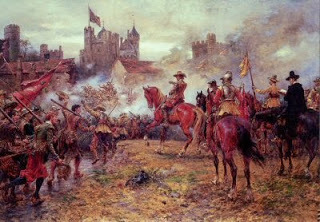
A Colonel Brereton approached the castle with his men and called on her to surrender. Isabel refused. The men set fire to some of the wooden buildings outlying the castle "to work their spirits to any relenting." Far from relenting, it led the Stafford force within to fire shots from the castle. The fires started in earnest then, "to provoke a serious revenge." But they could not damage the main castle, and in frustration retreated.
A relief force arrived and Lady Isabel left. But later that summer the garrison that was left to defend Stafford Castle fled when a large Parliamentarian army approached. On December 22nd, the Parliamentarian Committee of Stafford ordered "the castle shall be forthwith demolished" so that it could never again serve as a defendable source of opposition. And so it was.
The great Stafford Castle was no more. A traveler riding by wrote "the castle is now ruinated." The glory of the family and the castle that bore its name was finally over.
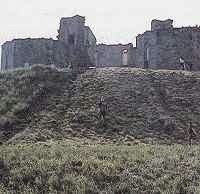
In 1813, a new family tried to rebuild Stafford Castle in the Gothic Revival Style but ran out of money. The keep, however, was occupied up until the 20th century by caretaker families who offered tours and served tea. In 1961, a member of the Stafford family, worried about public safety, gave the keep to the local authorities.
This castle has an unqualified happy ending, however. Stafford Castle has a thriving visitor centre today, running many education programs and for years has served as an inspiring backdrop for Shakespearean plays. Seeing that a few Staffords have appeared as characters in the plays of the Bard, this seems fitting indeed.
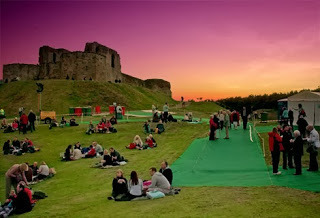 Summer Shakespeare, at Stafford Castle
Summer Shakespeare, at Stafford CastleTo learn more about Stafford Castle today, go here.
--------------------------------------------------------------------------------------------------------------
Please check out the blogs of the fantastic authors who have contributed to this castle hop. Lots of amazing giveaways!!
Elizabeth Ashworth
Gillian Bagwell
Lauren Gilbert
Katherine Ashe
Susanna Calkins
Katherine Pym
Maria Grace
J.A. Beard
Peter St. John
Grace Elliott
Deborah Swift
Sandra Byrd
Helen Hollick
Linda Root
Theresa Bohannon
Helena Schrader
Debra Brown
-----------------------------------------------------------------------------------------
I am giving away a paperback copy of The Crown and a hardcover of The Chalice as part of this blog hop, to residents of North America.
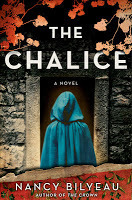 The Crown, an Oprah magazine pick of the month, was published in 2012 by Simon&Schuster's Touchstone in North America, Orion Books in the United Kingdom, DTV in Germany. It reached No. 1 in the United States on amazon and was on the short list of the United Kingdom's Crime Writer's Association's Ellis Peters Historical Dagger Award.
The Crown, an Oprah magazine pick of the month, was published in 2012 by Simon&Schuster's Touchstone in North America, Orion Books in the United Kingdom, DTV in Germany. It reached No. 1 in the United States on amazon and was on the short list of the United Kingdom's Crime Writer's Association's Ellis Peters Historical Dagger Award.The Chalice was published in 2013 by the United States and United Kingdom, and will be released in paperback in early 2014. Parade magazine said: "English history buffs and mystery fans alike will revel in Nancy Bilyeau's richly detailed sequel to The Crown."
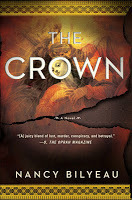 Please leave a comment below, telling me which book you would like, as well as your email.
Please leave a comment below, telling me which book you would like, as well as your email.
Published on September 22, 2013 19:34
Stafford Castle: All That Remained

By Nancy Bilyeau
It is a pleasure and honor to be included in the new anthology Castles, Customs, and Kings: True Tales by English Historical Fiction Authors.
I wrote five essays for the book, sharing my interest in Tudor England and, specifically, the turmoil of the Reformation. The protagonist of The Crown and The Chalice, Joanna Stafford, is fictional but the family was quite real. The Staffords played an important part in the Wars of the Roses, fighting on the side of Lancaster. But through a royal marriage and aggressive acquiring of land and titles, the Staffords became too rich and powerful as far as the reigning monarchs were concerned. Richard III had Henry Stafford, 2nd duke of Buckingham, executed for treason. A generation later, Henry VIII ordered the death of Edward Stafford, 3rd duke of Buckingham, also for treason.
 Edward Stafford, 3rd duke of Buckingham
Edward Stafford, 3rd duke of BuckinghamThe family's rise and fall is inextricably linked to Stafford Castle, in the west midlands. For this blog hop I would like to share some haunting images of the remains of this once proud medieval castle, which stands tall against the sky on the edge of a ridge.

The castle possesses a long, rich, and relatively well documented history, from the time Ralph de Stafford had it raised in 1347 to a rebuilding effort in the Gothic Revival Style in 1813. For this post, I would like to share a letter.
The family never recovered from the death of Buckingham in 1521. Although Stafford Castle was the family seat, the duke had lived most of the time in such grand homes as Thornbury Castle. All of this property was seized by the crown after Buckingham's death and his widow and children were left with nothing at first. But after a couple of years, Henry VIII returned one home--Stafford Castle--to the devastated clan. It was all that remained of their vast holdings across the kingdom.

The oldest son, Henry, Lord Stafford, lived at the castle with his wife, Ursula, and 14 children for the rest of his life. Fearful of drawing attention, he played no part in the politics and rarely attended court. He spent many pleasurable hours in his extensive private library. But he had almost no land beyond the immediate vicinity of the castle, and his need for money was intense.
That is why on April 27, 1536, Lord Stafford wrote this letter to Thomas Cromwell, chief minister of Henry VIII:
"Though I am least able to serve you, yet the comfort you gave me makes me bold to write to you. I beg you will use means with the King that I may have the farm of the abbey of Rantone, if it be dissolved. It is within four miles of my house and reaches my park pale, and I will give as much for it as any man. I heard that the Queen had moved the King to have me in remembrance for it, and he was content, saying it was alms to help me, having so many children on my hands. I heard that Geo. Blunt endeavours to obstruct my suit. By the last act of the Lords Marchers my income will be 20l. a year less. In the matter which I showed you of my lord of Wiltshire's motion, pray make my humble submission to the King."
The queen in question was Anne Boleyn and the "lord of Wiltshire" her father. Apart from the fact that it was unlikely that the Reform-minded queen would support the cause of an old Catholic disenfranchised aristocratic family, there were pressing matters in the kingdom that put Stafford's request at the bottom of any list. Cromwell was interrogating suspected lovers of the queen at the end of April. Anne Boleyn would be arrested and beheaded in May. Poor Henry Stafford had made his desperate plea for patronage of the wrong faction.

Henry Stafford had better luck when Mary Tudor succeeded to the throne. He petitioned the queen for financial assistance in 1554 and was made a chamberlain of the exchequer, a position that brought him 50 pounds a year.
Lord Stafford died in his bed at the age of 63. The castle continued to crumble, and his grandson referred to it as "my rotten castle of Stafford" in 1603. By the end of the 17th century the Staffords no longer lived in the castle that bore their name.
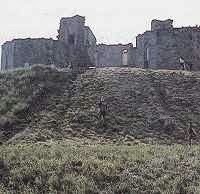
---------------------------------------------------------------------------------------------
To read more on the Castle Blog Hop, please go to http://www.linkytools.com/basic_linky_include.aspx?id=210634&AspxAutoDetectCookieSupport=1
Published on September 22, 2013 19:34
September 5, 2013
The Nun Who Challenged Henry VIII
Author Judith Arnopp is running a Tudor blog pageant, and asked me if I wanted to participate. I wrote a post about Sister Elizabeth Barton, a Benedictine nun who took on Henry VIII and paid the ultimate price.
She worked as a servant until, after recovering from a serious illness, she experienced visions so startling that all the churchmen up to the Archbishop of Canterbury proclaimed then genuine. Her life bears some resemblance to Joan of Arc's a century earlier. Because she was a threat to the king, Sister Elizabeth, the "Holy Maid of Kent," became a nonperson in the Tudor era. Most papers destroyed. All the chroniclers who wrote about her later in the century were Protestant. I have tried to restore to her some of the prominence she held in the dangerous 1530s, in my novels and in my blogging.
Please read the full post on Sister Elizabeth Barton here..
Published on September 05, 2013 04:49
August 26, 2013
Whitby Abbey: A haunting history
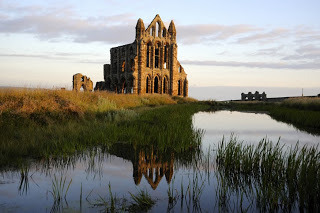
I have a passion for abbey ruins. Part of the reason is that I am writing a thriller trilogy set during the Dissolution of the Monasteries, and through my research I've discovered fascinating things about the world inhabited by my protagonist, a Dominican novice, in Dartford. But every ruin has a story to tell, and few are as enthralling as Whitby, in North Yorkshire...
To read more, go here.
Published on August 26, 2013 04:55



